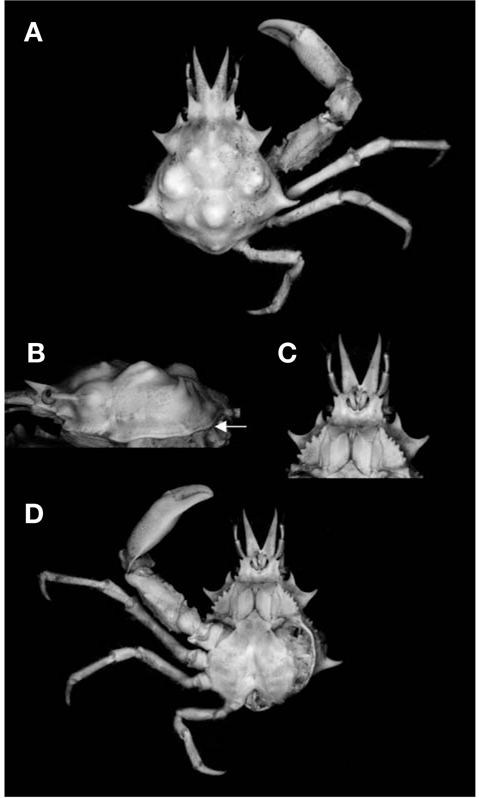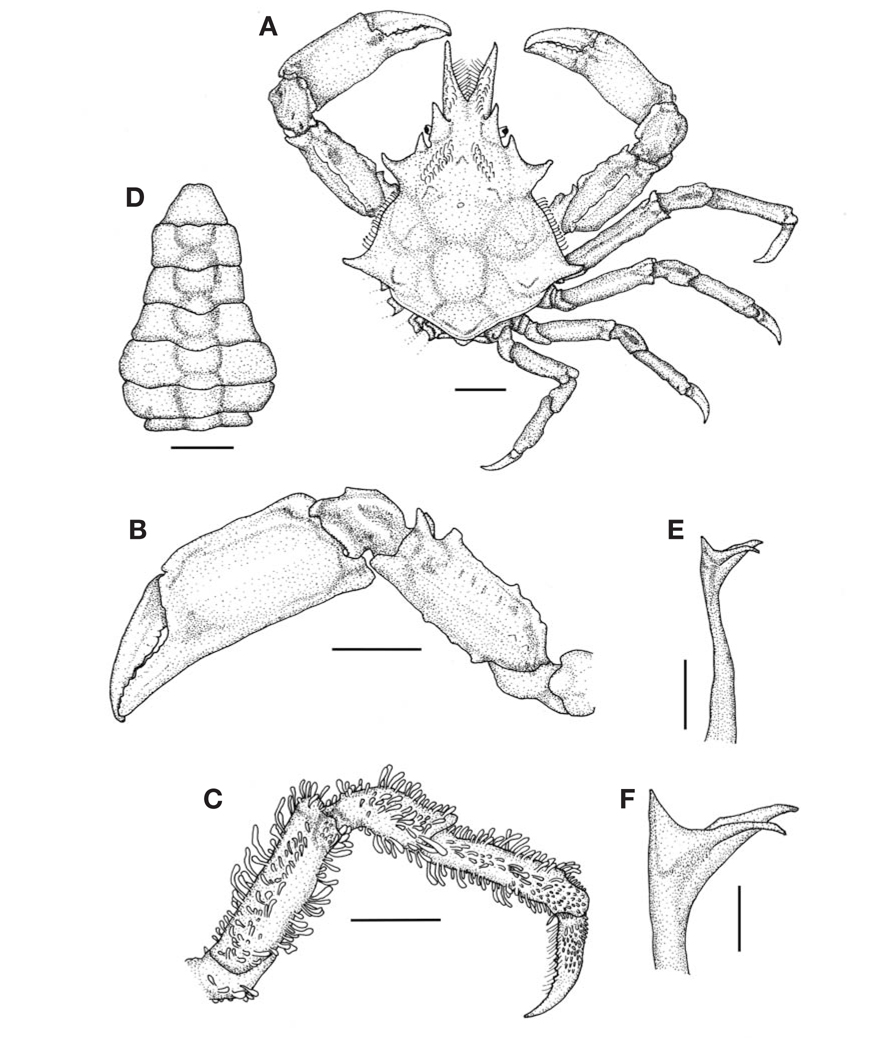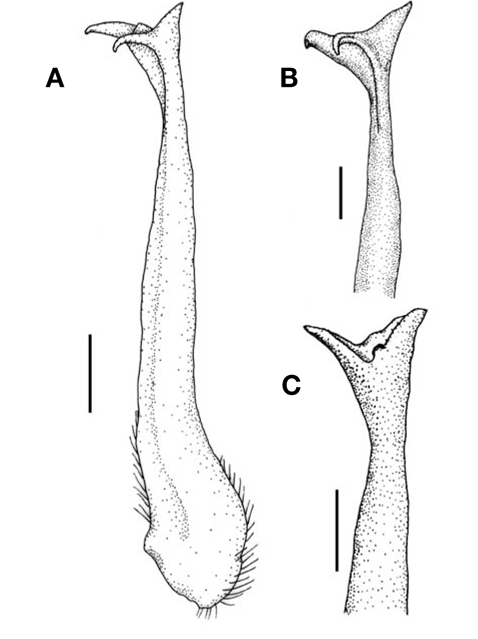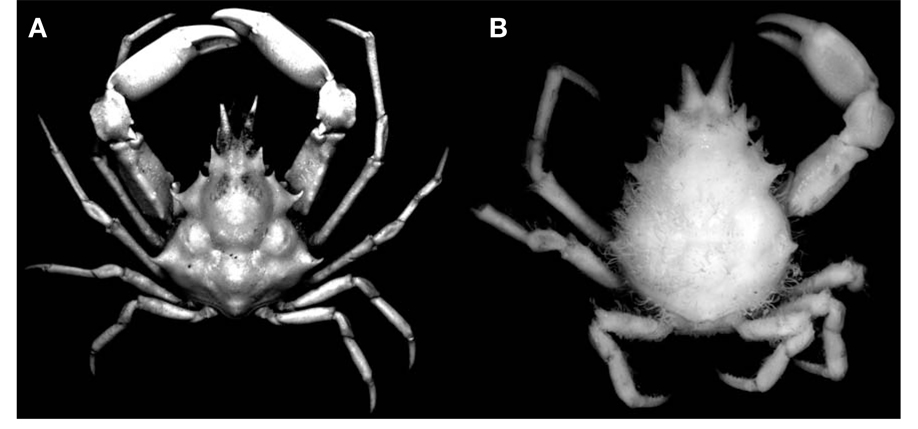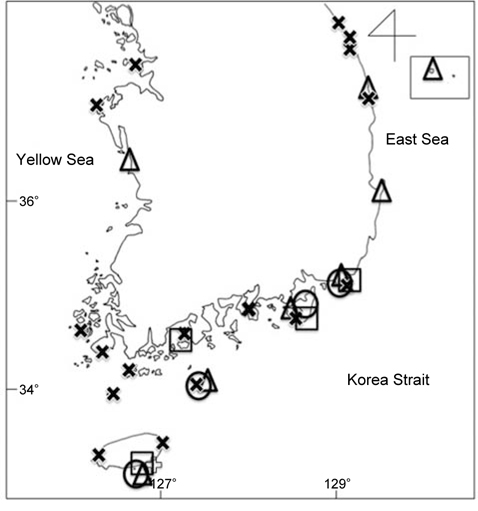The species of the genus Pugettia belonging to the superfamily Majoidea utilizes algae and sponges for camouflage, and occurs commonly on the rocky shores or in the tide pools of the coast. The genus Pugettia presently contains 19 species in the worldwide. Among them, twelve species occur in the West Pacific (Griffin and Tranter, 1986; Ng et al., 2008): Pugettia elongata Yokoya, 1933, P. incisa (De Haan, 1839), P. intermedia Sakai, 1938, P. kahoshimensis Rathbun, 1933, P. leytensis Rathbun, 1916, P. marissinica Takeda and Miyake, 1972, P. mindanaoensis Rathbun, 1916, P. minor Ortmann, 1893, P. nipponensis Rathbun, 1932, P. quadridens (De Haan, 1839), P. pellucens Rathbun, 1832, and P. similis Rathbun, 1932. Of these, only five species have been reported in Korean fauna: Pugettia incisa, P. intermedia, P. minor, P. quadridens, and P. pellucens (Kim, 1973; Kim and Kim, 1986, 1998). Pugettia quadridens intermedia Sakai, 1938 was elevated to P. intermedia by Griffin and Tranter (1986) based on several features, such as the first pleopod of male having the subequal length of two medial lobes, and a row of four tubercles above the epimeral ridge.
In Korea, Pugettia intermedia was firstly reported without description (Kim and Kim, 1986). Then, this species was redescribed with illustrations (Kim and Kim, 1998). Careful examination of previously reported P. intermedia in Korea revealed that those specimens were P. quadridens. Now, we report firstly P. intermedia in Korea based on the observation of specimens collected from Geojedo Island.
All specimens were preserved in 70% ethyl alcohol and were deposited in the “Marine Arthropod Depository Bank of Korea,” Seoul National University. All drawings were prepared using a camera lucida on a Nikon SMZ800 (Nikon, Tokyo, Japan). All characters were measured using a slide caliper (Wiha, Monticello, MN, USA) to the nearest 0.1 mm. Images were recorded using a digital SLR camera (D7000; Nikon), and were adjusted to provide a more descriptive image with software (Helicon Focus, Kharkov, Ukraine). The abbreviation “cl” and “cw” refer to carapace length from the tip of the rostrum to the posterior dorsal margin of the carapace and to the width of the carapace at the widest part, respectively.
Order Decapoda Latreille, 1802Family Epialtidae MacLeay, 1838
Pugettia intermedia Sakai, 1938 (Figs. 1, 2)Pugettia quadridens intermedia Sakai, 1938: 258; 1976: 197.Pugettia intermedia: Griffin and Tranter, 1986: 93; Muraoka, 1998: 24.Non Pugettia quadridens intermedia: Kim and Kim, 1986: 325; Kim and Kim, 1998: 302 [=Pugettia quadridens quadridens (De Haan, 1839)].
[Fig. 1.] Pugettia intermedia Sakai, 1938, male, cl 30.5×cw 20 mm. A, Whole animal, dorsal view; B, Branchial margin of carapace, left lateral view; C, Basal segment of antenna and third maxilliped; D, Whole animal, ventral view. Arrow indicates the epimeral ridge. cl, carapace length from the rostrum to the posterior margin of the carapace; cw, width of the carapace at the widest part.
Material examined. Korea: 1♂ (cl 30.5 mm, cw 20 mm), Gyeongsangnam-do: Geoje-si, Dongbu-myeon, beach Deokwon, 2 Mar 2006; 2 Inds., Busan: Haeundae-gu, Haeundae, 6 May 1973; 1 Ind., Jeju-do: Seogwipo-si, Isl. Munseom, 20 Jan 1977; 5 Inds., Seogwipo-si, Isl. Munseom, 1 Jul 1993; 1 Ind., Seogwipo-si, Isl. Beomseom, 2 Jul 1993; 2 Inds., Jeollanam-do: Yeosu-si, Samsan-myeon, Isl. Geomundo, 27 Jun 2002; 2 Inds., Incheon: Ongjin-gun, Isl. Seonjaedo, 19 Oct 2005; 1 Ind., Gyeongsangnam-do: Namhae-gun, Seol-ri, 1 Mar 2006.
Comparative materials. Pugettia incisa (De Haan, 1839): 1 Ind., Jeju-do: port Seogwipo, 28 Feb 1971; 1 Ind., Jeollanam- do: Goheung-gun, port Nokdong, 21 Apr 1996; 1 Ind., Busan: Haeundae-gu, Haeundae, 27 May 1996; 1 Ind., Gyeongsangnam-do: Geoje-si, Dongbu-myeon, beach Deokwon, 2 Mar 2006.
Pugettia minor Ortmann, 1893: 1 Ind., Jeju-do: Seogwiposi, Isl. Beomseom, 7 Feb 1971.
Pugettia pellucens Rathbun, 1932: 9 Inds., Busan: Haeundae- gu, Haeundae, 15 Jul 1971; 1 Ind., Gyeongsangbuk-do: Pohang-si, Guryongpo, 17 Jul 1972; 2 Inds., Jeollanam-do: Yeosu-si, Samsan-myeon, Isl. Habaekdo, 12 Jul 1984; 1 Ind., Gyeongsangbuk-do: Uljin-gun, Jukbyeon-myeon, 15 Jun 1985; 1 Ind., Chungcheongbuk-do: Borying-si, port Muchangpo, 7 Jun 1996; 2 Inds., Gyeongsangnam-do: Geoje-si, Nambu- myeon, Yoecha, 9 Jul 1996; 1 Ind., Geoje-si, Dongbumyeon, 29 Jan 1997; 1 Ind., Jeju-do: Seogwipo-si, Isl. Beomseom, 21 Feb 2001; 15 Inds., Tongyeong-si, Sanyang-eup, Isl. Mireukdo, 10 May 2006; 5 Inds., Geoje-si, Dongbumyeon, Yulpo-ri, 11 May 2006; 2 Inds., Gyeongsangbuk-do: Ulreung-gun, Isl. Jukdo, 11 Jun 2006.
Pugettia quadridens (De Haan, 1839): 1 Ind., Gyeongsangnam- do: Namhae-gun, Mijo-ri, 18 Jul 1967; 2 Inds. Jeollanam- do: Yeosu-si, Dolsan-eup, Impo-ri, 13 Jun 1969; 1 Ind., Jeju-do: Jeju-si, Isl. Chujado, 9 Aug 1969; 3 Inds., Busan: Haeundae-gu, Haeundae, 30 Jun 1971; 2 Inds., Gangwon-do: Sokcho-si, 25 Aug 1970; 2 Inds., Donghae-si, port Mukho, 25 Aug 1970; 3 Inds., Jeollanam-do: Jindo-gun, Hadong, 5 Aug 1974; 1 Ind., Gangwon-do: Gangreung-si, 5 Jul 1980; 13 Inds., Gyeongsangbuk-do: Uljin-gun, port Jukbyeon, 5 Aug 1983; 2 Inds., Jeollanam-do: Yeosu-si, Samsan-myeon, Isl. Geomundo, 11 Jul 1984; 1 Ind., Jeju-do: Jeju-si, Hangyeong- myeon, Sinchang-ri, 3 May 1985; 3 Inds., Jeollanamdo: Goheung-gun, port Nokdong, 22 Apr 1996; 3 Inds., Wando- gun, Bogil-myeon, 9 Aug 1996; 3 Inds., Gyeongsangnamdo: Geoje-si, Jangmok-myeon, beach Hongnam, 30 Jan 1997; 1 Ind., Jeollanam-do: Sinan-gun, Uido-ri, 5 Aug 1998; 3 Inds., Chungcheongnam-do: Taean-gun, Sinjindo-ri, 15 Jun 1999; 1 Ind., Jeju-do: Seogwipo-si, Seongsan-ri, 2 Nov 2000; 6 Inds., Incheon: Ongjin-gun, Seonjae-ri, 19 Oct 2005.
Description. Carapace (Figs. 1A, 2A) broadly triangular, naked; dorsal surface depressed; regions with distinctly deep grooves; gastric region with four tubercles, two median in transverse line between anterior and posterior ones, with series of curled hair on either side; cardiac region conical and mounted with tubercle; intestinal tubercle also distinct; branchial region with series of curled hair on either side. Rostrum (Figs. 1A, C, D, 2A) divergent at angle of about 50 degree; bases of rostrum flattened, tips acuminate, curved outwards, series of curled hair on either side. Hepatic spine slender, curved forwards at tip. Lateral brachial spine very prominent, projecting backwards, upward and forwards at tip; two tubercles on epibranchial region, another on inner side of lateral spin. Preocular spine very acuminate. Posterior angle of supraocular eave rounded angle. Postocular tooth as strong as hepatic spine. Pterygostomian ridge (Fig. 1C) with four or five tubercles. Sub-branchial margin (Fig. 1B) above epimeral ridge with irregular row of three or four tubercles.
Chelipeds (Figs. 1A, D, 2A, B) stout, ischium with two lobular on anterior border; merus with strong ridge or row of tubercles halfway down, and slightly outward in distal portion.
Ambulatory legs (Figs. 1A, D, 2A, C) with velvet-like tomentum, fringed with club-shaped hairs on anterior and posterior edges.
Abdomen of male (Fig. 2D) consisting of 7 segments with fine seta; third sternite widest; telson broad triangular.
First pleopod of male (Fig. 2E, F) slender, length of two medial lobes subequal.
[Fig. 2.] Pugettia intermedia Sakai, 1938, male, cl 30.5×cw 20 mm. A, Whole animal, dorsal view, omitted club-shaped hair on anterior and posterior of ambulatory legs; B, Outer view of left cheliped; C, Posterior view of fourth ambulatory leg; D, Male abdomen; E, Right first pleopod, outer view; F, Tip of right first pleopod, outer view. cl, carapace length from the rostrum to the posterior margin of the carapace; cw, width of the carapace at the widest part. Scale bars: A, B, D=5 mm, C=2.5 mm, E=1.5 mm, F=0.5 mm.
Habitat. Rocky and weedy bottoms.
Distribution. Korea, Japan, Northern China, and Taiwan Strait (type locality: Shimoda, Japan).
Remarks. The authors carefully examined the some specimens of P. intermedia of Kim and Kim (1986), as well as the specimens and the description about P. intermedia of Kim and Kim (1998). As a result, those specimens were identified as Pugettia quadridens because of the following characteristics: 1) the two medial lobes of the first pleopod of the male P. intermedia are subequal, while in P. quadridens one of the two medial lobes is about half length of the other one (Figs. 2E, F, 3A); 2) there are three or four small tubercles on the branchial submargin above the epimeral ridge of P. intermedia (Fig. 2E, F), but that of P. quadridens exhibits just one or two such tubercles (Fig. 1B).
In regard to the male first pleopod of Korean species belonging to the genus Pugettia, that of P. quadridens is similar to that of P. pellucens but they have different seta patterns on the carapace (Fig. 3A, B), and P. pellucens is smaller than P. quadridens (Fig. 4). Pugettia incisa has a long slender medial lobe and a small triangular lobe on the ventral surface at the tip (Fig. 3C), and this species has the postorbital lobe and the hepatic spine fused as a sing plate with the lateral margin of the carapace. This character distinguishes it from all other species in the genus.
[Fig. 3.] Left first pleopod, ventral view. A, Pugettia quadridens (De Haan, 1839), cl 37.5×cw 24.1 mm; B, Pugettia pellucens Rathbun, 1932, cl 13.4×cw 8 mm; C, Pugettia incisa (De Haan, 1837), cl 21×cw 14 mm. cl, carapace length from the rostrum to the posterior margin of the carapace; cw, width of the carapace at the widest part. Scale bars: A=1 mm, B, C=0.5 mm.
[Fig. 4.] Whole animals, dorsal view. A, Pugettia quadridens (De Haan, 1839), male, cl 37.5×cw 24.1 mm; B, P. pellucens Rathbun, 1932, male, cl 13.4×cw 8 mm. cl, carapace length from the rostrum to the posterior margin of the carapace; cw, width of the carapace at the widest part.
In regard to the distribution of Korean species in the genus Pugettia based on the examined specimens, P. quadridens and P. pellucens occur throughout all coasts of the peninsula while P. intermedia and P. incisa occur only on the southern coast. Pugettia minor was only collected from Isl. Beomseom, Jeju-do, in 1971, and since then, this species has not been collected (Fig. 5).




